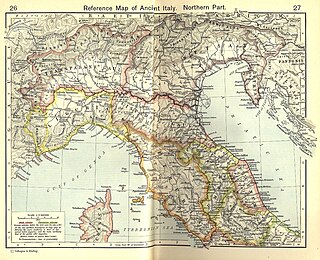Related Research Articles
The Calucones were a Gallic or Rhaetian tribe dwelling around present-day Chur during the Roman period.

The Vinschgau, Vintschgau or Vinschgau Valley is the upper part of the Adige or Etsch river valley, in the western part of the province of South Tyrol, Italy.
The Medulli were a Gallic tribe dwelling in the upper valley of Maurienne, around present-day Modane (Savoie), during the Iron Age and Roman period.
The Seduni were a Gallic tribe dwelling in the upper Rhône valley, around present-day Sion, during the Iron Age and the Roman period.
The Nantuates or Nantuatae were a Gallic tribe dwelling around present-day Massongex, in the modern Canton of Valais (Switzerland) and adjacent areas of France, during the Iron Age and the Roman period.
The Salassi or Salasses were a Gallic or Ligurian tribe dwelling in the upper valley of the Dora Baltea river, near present-day Aosta, during the Iron Age and the Roman period.
The Caturiges were a Gallic tribe dwelling in the upper Durance valley, around present-day towns of Chorges and Embrun, during the Iron Age and the Roman period.

The Vindelici were a Gallic people dwelling around present-day Augsburg (Bavaria) during the Iron Age and the Roman period.
The Acitavones were a small Gallic tribe dwelling in the Alps during the Iron Age.
The Nemeturii or Nemeturi were a Gallic tribe dwelling in the Alpes Maritimae during the Iron Age.
The Ecdinii or Ecdini were a Gallic tribe dwelling in the valley of the Tinée (Alpes-Maritimes) during the Iron Age.
The Vesubiani or Vesubianii were a Gallic tribe dwelling in the valley of the Vésubie river during the Iron Age.
The Quariates or Quadiates were a Gallic tribe dwelling in the valley of Queyras, in the Alps, during the Iron Age.
The Vennones or Vennonetes were a Rhaetian tribe dwelling in the northern Alps, between Chur and Lake Constance, during the Iron Age and the Roman era.
The Ucennii,Ucenni or Iconii were a Gallic tribe dwelling in the Romanche valley, in the Alps, during the Iron Age.
The Vergunni were a Gallic tribe dwelling in the valley of the Riou, near the Verdon river, during the Iron Age.
The Sogionti or Sogiontii were a Gallic tribe dwelling around present-day Sisteron during the Iron Age.
The Gallitae were a Gallic tribe dwelling in the upper valley of the Bléone river (Alpes-de-Haute-Provence) during the Iron Age.
The Brixentes or Brixenetes were a Celtic or Rhaetian tribe living in the Alps during the Iron Age and the Roman era.

The Isarci were an ancient Alpine people who settled in the Eisack Valley.
References
- ↑ Talbert 2000, Map 19: Raetia.
- ↑ Jules Formigé: La dédicace du Trophée des Alpes (La Turbie). In: Gallia. Vol. 13, 1955, No. 1, p. 101—102.
- ↑ Waldherr 2006.
- ↑ Bundi 2014.
Primary sources
- Pliny (1938). Natural History. Loeb Classical Library. Translated by Rackham, H. Harvard University Press. ISBN 9780674993648.
Bibliography
- Bundi, Martin (2014). "Val Venosta". Historisches Lexikon der Schweiz .
- Talbert, Richard J. A. (2000). Barrington Atlas of the Greek and Roman World. Princeton University Press. ISBN 978-0691031699.
- Waldherr, Gerhard H. (2006). "Venostes". Brill's New Pauly. doi:10.1163/1574-9347_bnp_e12200260.
